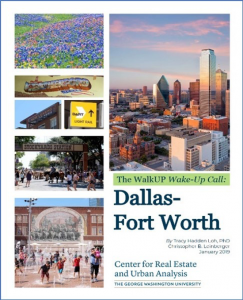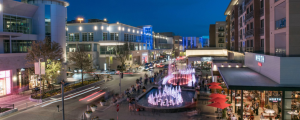Since Covid-19 hit, much has been said about the flight of people from the city to the suburbs. While the full extent of urban migration—or exodus—is unknown, it’s important to consider some underlying facts that can help you capitalize on these trends in both the near- and long-term.
Cities and regions that recognize the nuances here will be far better positioned to market themselves from a place-branding and economic development perspective while simultaneously exploring changes in land use, zoning, transportation/mobility, and infrastructure. Capitalizing on “place branding” or Place-Based Economic Development (PBED) isn’t just about pursuing a wise investment, it’s about embracing the future.
To understand the context of the recent upswing in suburban living, it is important to note three key dynamics at play.
Shifts Already Underway Are Now Accelerating
As I’ve written in other articles on the commercial real estate sector, existing trends have already demonstrated a shift in lifestyle preference that suggests growing desire for suburban living as opposed to the urban core/big city life. Driven by millennials, this new trend makes a lot of sense as suburban regions generally offer more space per dollar in addition to better schooling options. As our largest generational cohort continues to move toward family living, so too will their housing choices evolve.
However, those choices will not be made according to what their parents and grandparents desired. After all, this is the generation that shunned the boring burbs for the big city. Their desire for urbanism, walkability, and vibrancy remains, and the question now is how will the suburbs provide that lifestyle? It’s a whole new suburban world out there.
People Want Walkable and Amenity-Rich Suburbs
A shift toward more suburban style living does seem to be in effect, however, our suburban ideal is far different than in the past. Today’s resident desires want more than a home, a white picket fence, and a series of shopping malls—they want space and community.

The areas in the greatest demand, as shown through price premiums, are those suburbs that also provide an urban lifestyle through vibrant walkable districts—think suburban downtowns that are pedestrian friendly, with smaller streets banked by retail and restaurants, or newer mixed-use developments that are centers of commercial, residential, and cultural activity.
There have been a number of studies that demonstrate this ongoing trend including Walk-Up Wake Up Call series conducted by renowned author and urbanist Chris Leinberger of George Washington University (full disclosure: I was involved in most recent efforts in the NY/NJ Metro and DFW) and a recent study conducted by Cushman & Wakefield.
Walkability is Now Preferred Over the Car-Centric Lifestyle
We often think of “urban” as the city: big, dense, and full of traffic. The suburbs, on the other hand, are low density, single-family homes, residential in nature, and with big-box shopping malls.
The reality is quite different. Cities have entire neighborhoods that are “suburban” in nature and entirely automobile dependent. Increasingly, suburbs are investing in building more active, mixed-use nodes that include walkability, transit, and mobility options other than the car. The real distinction is less urban vs. suburban, and more walkable urban vs. drivable suburban.
Those environments can and do exist in a range of locales, city and suburb alike. The aforementioned Walk-Up Wake Up Call is a great resource for understanding the evolution from city vs. suburb to walkable vs. drivable.
One important idea that suburbanites and real estate shoppers around the nation should take note of is that there exists a “best-of-both-worlds” approach. The ideal situation for many is to live in a single detached home within a bedroom community that is within walking distance to a downtown or mixed-use center. However, this often comes at a significant price premium, and often at the expense of additional square footage and yard.
For those who either cannot afford suburban living on the edge of an urban district or desire more space, a growing segment of the market seeks to be no more than a short drive away from such an environment. Those regions that host a larger number of these desirable walkable neighborhoods hold a clear competitive advantage for a segment of the market that is not only growing, but is a key driver for corporate relocation decisions as companies follow talent. (Yes, even when more of us will be working from home, after all, if you’re working from home, it is more important to have access to a variety of environments and experiences, especially those that were once available around the workplace).
So, what does this mean for you, especially if you are a city manager, economic development agency, or a community leader who wants to attract more people to your area? Two things.
- Highlight Walkable Neighborhood Assets You Already Have…
Use what’s called Place-Branding as a tool that differentiates your region from the competition. Tell a story that conveys the best of suburban home life with access to cool, walkable, and culturally rich enclaves. And market the heck out of your downtowns, your new mixed-use projects. Highlight transit connections, mobility options, and transit-oriented development.
Some people (and businesses!) may want to move to those downtowns and mixed-use projects. Many more want to live within a walk or short drive of work. If you have such neighborhoods today, leverage that competitive advantage in your messaging, marketing, promotions, and in your economic development and corporate retention/attraction strategies.
- …But Plan for the Kind of Growth that the Market Is Calling For.
The time has long passed when traditional Euclidian zoning and single-use, car-dependent sprawl met market needs. This is even more true for the younger workforce, millennials with or without families, and the employers who move to regions specifically to tap into this segment of the workforce.

Use Place-Based economic development strategies that focus on talent retention and attraction as a key driver for corporate relocation decisions. Encourage (and at the least, make legal) the development of mixed-use projects that offer the necessary densities to make a district hop. Explore the suburban transformation of strip malls into walkable districts that contain a significant and needed residential component. Added benefits of this include more residential uses resulting in greater regional housing affordability and the expansion of local spending power to uplift the local economy. Both issues are all the more pressing with covid-related reductions in municipal tax revenues and local spending.
In addition, take a fresh look at the nature of your transportation and infrastructure: invest in walkability, bikability, mobility, and connectivity. Those investments will have far greater ROI than another overly wide, car-only road with low tax generating (and often struggling) retail and parking lots on either side.
Yes, our world is changing. Many of these changes were already underway, but today’s crisis has resulted in fast-tracking. If you do these two things, the result will be an enormous economic development advantage for your city, with improved quality of life for residents and increased economic activity and tax revenue generation to help local business for a generation.
Sign up for the TopRight blog! You can also visit me on LinkedIn. And if you still want more marketing insight, think about picking up a copy of one of TopRight’s latest offerings: Strategic Analytics and/or Marketing, Interrupted.